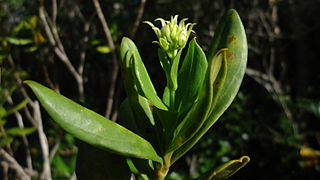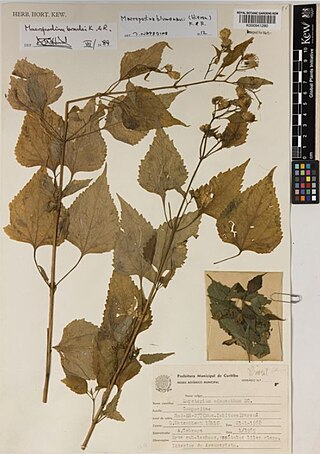
Eupatorieae is a tribe of over 2000 species of plants in the family Asteraceae. Most of the species are native to tropical, subtropical, and warm temperate areas of the Americas, but some are found elsewhere. Well-known members are Stevia rebaudiana, a number of medicinal plants (Eupatorium), and a variety of late summer to autumn blooming garden flowers, including Ageratum (flossflower), Conoclinium (mistflower), and Liatris.

Paul Carpenter Standley was an American botanist known for his work on neotropical plants.

Acritopappus is a genus of flowering plants in the family Asteraceae described as a genus in 1972.
Adenocritonia is a genus of flowering plants in the family Asteraceae described as a genus in 1976.
Asanthus is a small genus of flowering plants in the family Asteraceae, found only in northern Mexico and the southwestern United States.
Brickelliastrum is a North American genus of flowering plants in the tribe Eupatorieae within the family Asteraceae. Its species are native to Arizona, New Mexico, and Texas in the United States and to northern Mexico.
Grazielia is a genus of South American flowering plants in the family Asteraceae.

Litothamnus is a genus of Brazilian flowering plants in the tribe Eupatorieae within the family Asteraceae.
Lomatozona is a genus of Brazilian flowering plants in the tribe Eupatorieae within the family Asteraceae.
Lourteigia is a genus of South American flowering plants in the tribe Eupatorieae within the family Asteraceae.

Macropodina is a genus of South American flowering plants in the tribe Eupatorieae within the family Asteraceae.

Macvaughiella is a genus of Mesoamerican flowering plants in the tribe Eupatorieae within the family Asteraceae.

Peteravenia is a genus of Mesoamerican plants in the tribe Eupatorieae within the family Asteraceae.
Piptothrix is a genus of Mesoamerican plants in the tribe Eupatorieae within the family Asteraceae.
Piqueriella is a genus of a Brazilian plants in the tribe Eupatorieae within the family Asteraceae. The genus contains a single described species, Piqueriella brasiliensis, found only in the State of Ceará in northeastern Brazil.

Raulinoreitzia is a genus of South American plants in the tribe Eupatorieae within the family Asteraceae.
Revealia is a genus of Mexican plants in the tribe Eupatorieae within the family Asteraceae. The only known species is Revealia macrocephala, native to the Mexican State of Guerrero.
Sartorina is a genus of flowering plants in the tribe Eupatorieae within the family Asteraceae.
Spaniopappus is a genus of Cuban plants in the tribe Eupatorieae within the family Asteraceae.
Steyermarkina is a genus of South American plants in the tribe Eupatorieae within the family Asteraceae.







